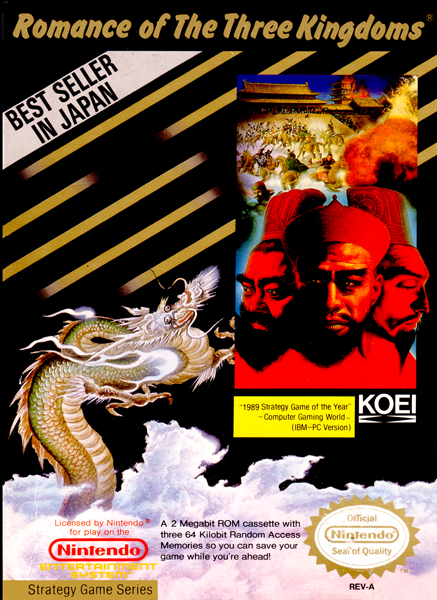
Romance of the Three Kingdoms
System: NES
Release Date: October 1989
Developer: Koei
Publisher: Koei
Genre: Grand Strategy
Romance of the Three Kingdoms is another of Koei’s long-term grand strategy series. It’s the followup to Nobunaga’s Ambition and in ways is a step forward and in others a step back. Instead of being set in feudal Japan, our setting is 2nd and 3rd century China. There are five scenarios to choose from, each with different starting and winning conditions. All of them task you with uniting an increasing number of states.
I tried two games, each in Scenario 1 as Cao Cao (Ts’ao Ts’ao). Cao Cao is probably the best character to start with because his stats are super high. My first thought was to develop my regions by spending a crap ton of gold. What I learned is that was a mistake. Spending a crap ton of gold on development is a waste. There was no difference between spending 10 and 100 gold and not a real difference between 100 and 1000 gold. Instead of having a turn per season, as in Nobunaga, you have a turn each month. This leaves you with plenty of time to develop your towns.
There are a number of different options to choose from each turn. You can move your armies, attack adjacent states, or move supplies between owned regions. If you want more armies or men in the armies, you can recruit them from enemy generals, free generals, and men from the region. To increase stats, you can give presents to your generals or peasants, develop the land, planting new fields and building dams, or training up your armies. It’s possible to search for hiding generals to join you, take part in diplomacy to make enemy generals like you by giving gifts or marrying off daughters, and trade with merchants to gain gold or rice and buy weapons to strengthen armies.
Of course, there are battles. They aren’t nearly as prevalent as in Nobunaga, but they are certainly much longer to get through. Each General you have in your region can enter battle and they have their own number of men under them. The stronger the general, the better the army. When you attack, you win by defeating the master of the region, wiping out all generals, running their rice supplies down, or taking control of every castle. If you have enough generals, controlling every castle is a great strategy, because one type of attack is setting fire to a square. The fire tends to move with wind direction, giving you a way to smoke your enemies out.
On defense, you win if the attacker runs out of rice, if you hold out for thirty days of attack, if you seize the attacker’s rice, or if you capture the attacking commander. I was able to dig in and hold out for thirty days when I was attacked. They always seemed to want to go after my rice. If I can be totally honest, Romance of the Three Kingdoms is incredibly slow, whether it’s the battles or waiting between your turns on the world map. I almost quit and gave it a short, poor review, but I tried a different strategy in my second game and started to enjoy myself. Another positive is you can play with up to 8 players, so if you’ve got some buddies, a weekend with nothing to do, and a crap ton of pizza and booze, you can have a good time.
Graphics: 1.5
Graphics aren’t really that great. There aren’t a lot of animations, and the terrain isn’t very detailed.
Sound: 0.5
The music loops so quickly and isn’t very good. My wife was next to me while I played for a little bit and she demanded I make the sound go away.
Gameplay: 2.0
The slow speed of the game leads to mistaken button presses. If you decide not to do something, you can’t just go back one decision, but must start from the beginning. Seriously, everything is way too slow.
Difficulty: 3.0
Romance is as difficult as its predecessor. It’s going to take a long time to unite China. I think a good strategy is easier to find than you might think.
Fun Factor: 2.5
There is a learning curve, which makes your first couple hours a chore, but once you start to figure out what you’re doing, the fun opens up.
Overall Grade: 1.9
Romance of the Three Kingdoms earns a C. I think there is a lot of promise here and it obviously gets better to warrant 14 main titles in the series.
